Report

At a Glance
- Consumer segments in Asia-Pacific concerned about environmental, social, and corporate governance issues are on par with Europe and the US.
- Brand owners face a fundamental challenge: Consumers indicate they want to buy sustainable goods and are even willing to pay premium prices for them, but few actually follow through. We call this the “say-do gap.”
- Among more than 16,000 consumers surveyed in the region, 15% don’t buy sustainable goods because of a lack of information or the simple fact that they don’t trust claims of sustainability. Another 10% mentioned low availability. Only 16% cite price as a barrier.
- Companies that close the say-do gap set themselves up for success. Four out of five environmentally and socially conscious consumers in Asia-Pacific actively recommend sustainable products that they like, and more than half of these consumers are “super promoters,” meaning they recommend the product to more than 10 people.
The world’s consciousness for a widening range of environmental, social, and corporate governance (ESG) challenges is rising rapidly, and nowhere is it growing faster or more dramatically than in the Asia-Pacific region. Similar to their counterparts everywhere, consumer products executives who serve the area’s populous and expanding markets are now racing to figure out what it means for their businesses and brands.
To address these critical questions and scratch beneath the surface on Asia-Pacific consumers’ views on sustainability, we performed the most extensive research ever conducted on the issue. We surveyed more than 16,000 consumers across 11 countries and 7 consumer products categories, supplemented with more than 55 hours of deep-dive interviews. Our research helped bring the region’s consumers into sharper focus, debunking long-held myths in the process and bringing some of the unexpected challenges to the surface.
Understanding Asia-Pacific consumers’ new embrace of sustainability starts by tracking the broader global movement and how rapidly it is gaining momentum in the region.
Nearly 200 countries have now ratified the Paris Accord to limit global warming to 1.5°C, and more than 127 countries have now imposed taxes or bans on plastic bags. China announced restrictions on overpackaging in food and cosmetics starting in 2023, for example, and India is banning single-use plastics. Both Japan and South Korea have committed to a 2050 carbon neutral deadline, and Singapore has announced an ambitious green plan that calls for reducing waste sent to the landfill per capita per day by 30% by 2030, among other moves.
Sustainability is also an increasingly important issue for investors, with 78% of global investors saying that they place more emphasis on ESG now than they did five years ago and 65% believing that ESG will become standard practice over the next five years. Singapore requires all listed companies to provide climate reporting, and India has mandated that its top 1,000 listed companies do the same starting in 2023.
Just as swiftly, sustainability in its many dimensions has emerged as a key issue for employees. For example, in Asia-Pacific, 75% of employees now expect their companies to follow sustainable business practices.
But while regulators, investors, and employees are steadily clamoring for change, it is becoming clearer and clearer that consumers are a key force in the sustainability movement, which is broadening in scope to encompass a range of environmental threats as well as social, economic, and governance challenges—everything from product health impacts to racial equity to gender rights to food equality.
As one indicator of the increased consumer interest, consider that Google searches for ESG terms increased more than 20-fold in South Korea and more than 30-fold in Indonesia over the past five years. We asked consumers across the region to rank the relative importance of various purchasing criteria. Good for the planet ranked third, following health benefits and quality. Relative importance varies among regions. For example, Asia-Pacific consumers ranked health benefits as their top criteria; consumers in Europe ranked quality (see Figure 1).
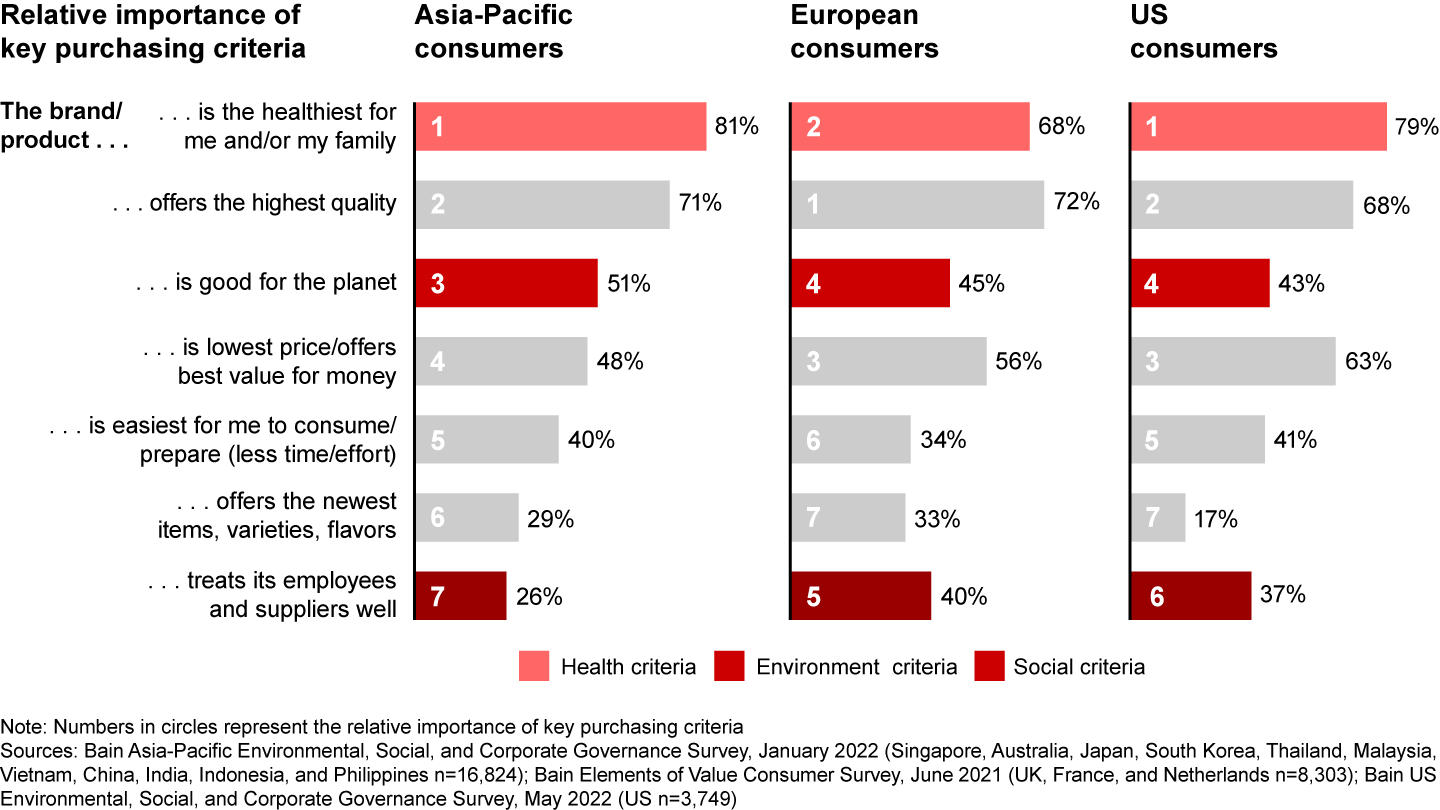

When asked what entity should have primary responsibility for helping consumers shop for sustainable products, respondents say that brands and governments are the top two groups responsible for leading the change, and in 4 of 11 countries, they say that brands should do even more than governments (see Figure 2).
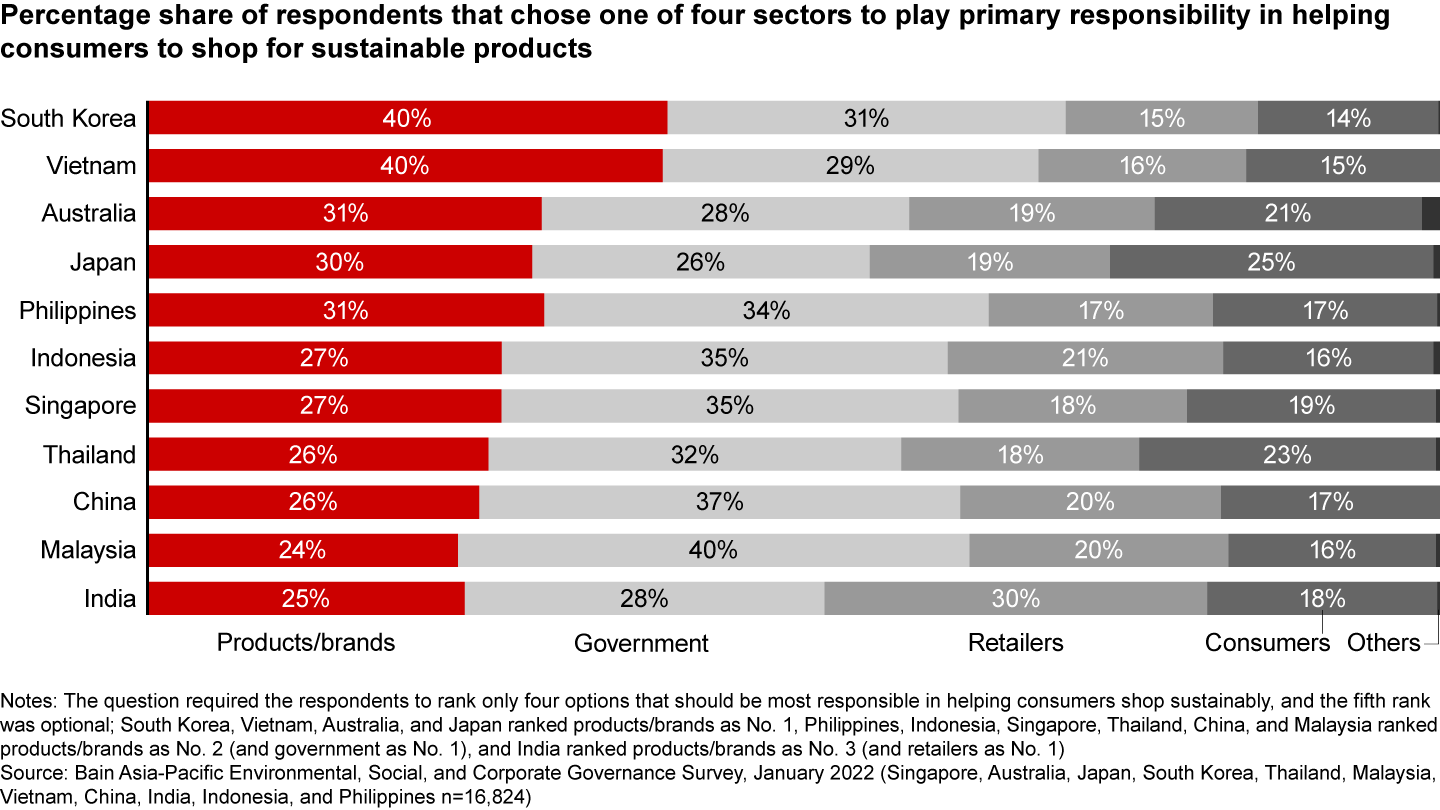

The trouble is that many brand owners readily admit they have not made as much progress as they had hoped and don't know how to move ahead. They are struggling to understand what sustainable shoppers want and why more are not following through on their commitments. While many brand owners say they are committed to improving the sustainability of their products and businesses, few have identified scalable solutions to meet their ambitions, and even fewer are confident there will be positive returns on the investments they are considering.
Above all, brand owners want to start at the beginning of this chain with the consumer and overcome a fundamental challenge that we call the “say-do gap”: Continuing research has found that while many consumers indicate they want to buy sustainable goods and are even willing to pay premium prices for them, few actually follow through.
Consumers face multiple obstacles even before they get to check out, starting with a foundational understanding of which characteristics of a product make it more or less sustainable. The stepping off point in consumer understanding of sustainability is one of the most fundamental challenges. About 70% of those surveyed failed a simple sustainability quiz, and consumers with higher levels of education, while more confident in their answers, did not fare better in the quiz. A key issue is that consumers feel overwhelmed by (often conflicting) information, with more than 90% of respondents consulting at least three sources to find out about a brand and verify its claims. In this report, we explore the critical roadblocks between intention and action, offering ways that companies can overcome them.
Embedding sustainability into their brand’s core is critical for consumer products companies hoping to deliver a real ESG transformation. We interviewed 20 executives of large consumer products companies, and all agreed that they are making sustainability a priority and devoting more time to it. Yet 50% said they needed a bolder ambition, and 100% said they required significant work to fully embed sustainability into the core of their business. Conversely, many insurgent brands in Asia-Pacific and throughout the world are born sustainable, focusing on a short list of ESG elements that are an integral part of the brand purpose and proposition.
In India, baby care insurgent Mama Earth offers toxin-free natural adult and baby care products; it also contributes to tree planting. Consumers get confirmation of a sapling they helped to plant as soon as they place an order. In the Philippines, personal care brand Human Nature, which engages in no animal testing, pays more than a fair wage to less-affluent communities in the Philippines, where it obtains many of the ingredients for its products. In Australia, a company named Who Gives a Crap produces 100% recycled toilet paper (bamboo or paper) and donates 50% of its profits to ensure wider access to clean water and toilets.
These and other insurgents provide invaluable lessons for traditional consumer products companies that are exploring ways to embed sustainability into their brands as they learn about Asia-Pacific’s sustainable consumers.
Meet Asia-Pacific’s Sustainable Consumers
To understand the key motivations behind consumer behavior, we examined five broad consumer segments based on how much they care about sustainability and their purchasing preferences. This set the context for determining sustainability’s influence and comparing it with other regions. Two of these five consumer segments (both of which relate to sustainability) are as large or larger in Asia-Pacific than in Europe or the US. This was the first of many unexpected findings.
Environmentally and socially conscious: These consumers are primarily focused on the environment and social issues. They want to purchase healthy products that are good for the planet from companies that show concern for their employees and suppliers. Environmentally and socially conscious consumers represent 14% of all consumers across Asia-Pacific, Europe, and the US.
Health conscious: These consumers are primarily concerned with making healthier choices for themselves and their families, often considering sustainable products as a route to better health. The health conscious represent 51% of all consumers in Asia-Pacific, far more than Europe (27%) and the US (31%).
Value seekers: Consumers who are committed to money-saving tactics above all represented 13% of shoppers in Asia-Pacific, well below the 21% in Europe and 22% in the US.
Quality conscious: In Asia-Pacific, 15% of consumers focus on high-quality products and variety compared with 29% in Europe and 27% in the US.
Lifestyle seekers: Only 7% of Asia-Pacific consumers prioritize convenience above all vs. 9% in Europe and 12% in the US.
Asia-Pacific markets care about the environment just as much as Western markets—and they care even more about health-related ESG matters. Our research determined that the region’s consumers are as concerned about environmental issues as those in Western countries and that they care more about health as a purchasing criterion (see Figure 3). Also, they are less concerned than their counterparts in Europe about social criteria.


Fast-growth markets care more than mature markets. Another surprising discovery was that it isn’t only consumers in the more developed countries that are motivated by environmental and social issues. In fact, the opposite is true. Consumers surveyed in the region’s fast-growing markets (China, India, Indonesia, Thailand, Malaysia, the Philippines, and Vietnam) are more conscious of environmental and social factors than those in the more mature markets of Australia, Singapore, Japan, and South Korea. As an extreme example, the environmentally and socially conscious segment of consumers is five times greater, on a percentage basis, in China than in Japan (see Figure 4).
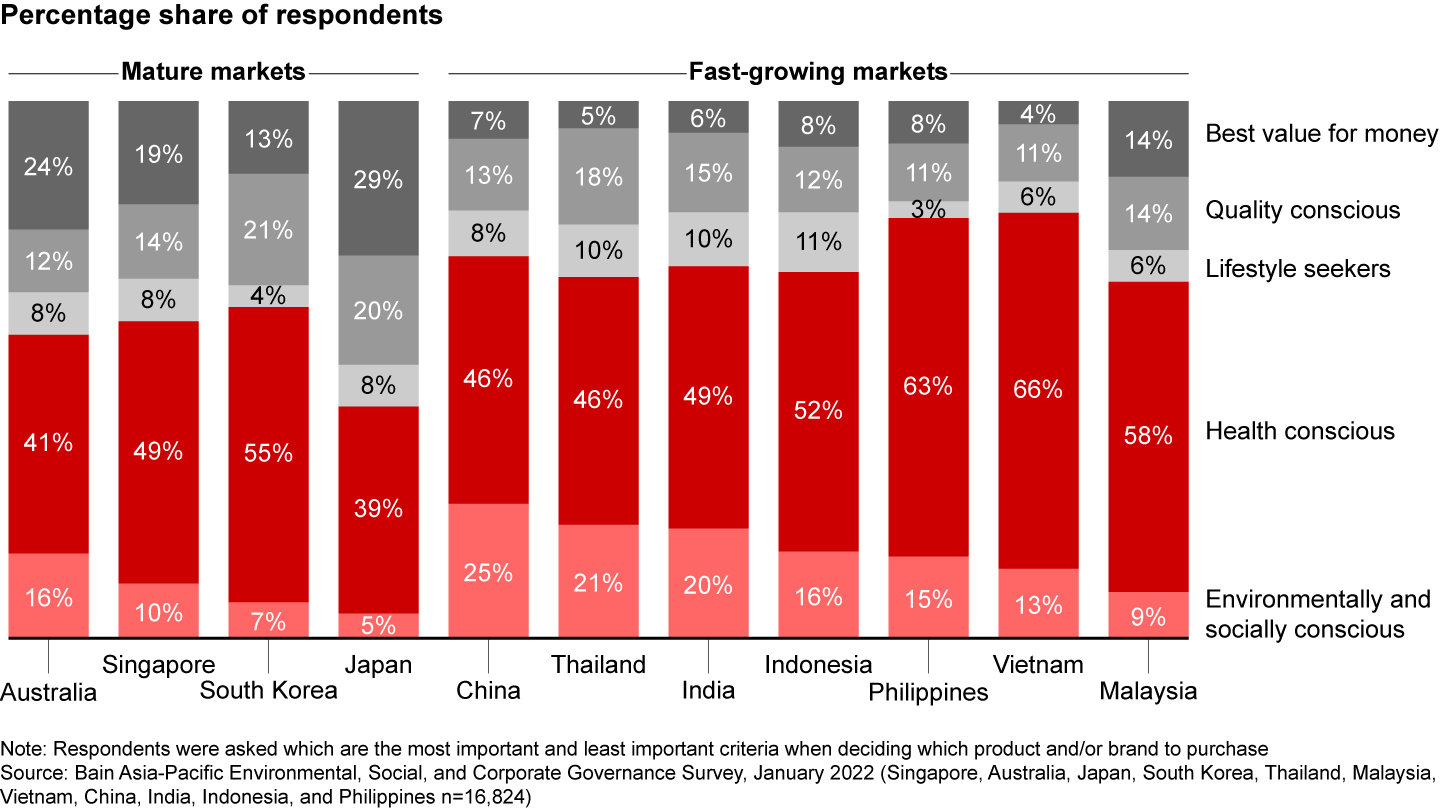

One possible explanation is that witnessing the impact of environmental issues first-hand in fast-growing markets makes these threats real and tangible. The average pollution level (measured in fine particle matter) is significantly higher in India and China than it is in Australia, for example, and 7 of the 15 countries with the highest mismanaged plastic pollution are fast-growing Asian markets. Indeed, environmental issues are a powerful personal trigger for sustainable purchases. When asked to name the factors that motivated them to start buying sustainable products, five times more Asia-Pacific consumers cited “the personal impact of environmental issues” than mentioned “having a child” (see Figure 5).
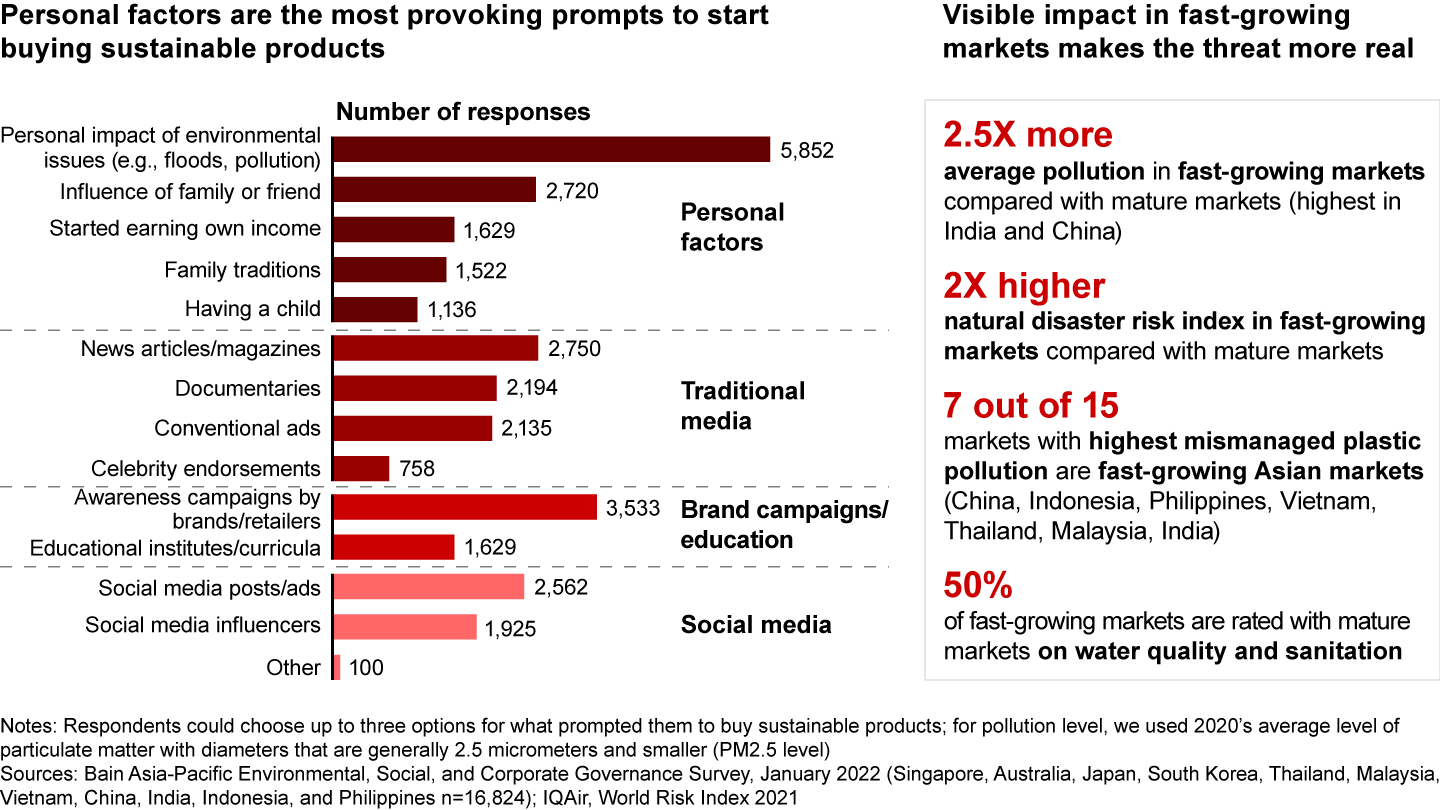

Sustainability is equally important across age and income groups. Our research busted another popular myth—namely, that only young and affluent consumers are truly sustainability conscious. Across Asia-Pacific, the percentage share of consumers identifying as both environmentally/socially conscious and health conscious was roughly the same for survey participants aged 18 to 34 years old as it was for those aged 60 years and older (see Figure 6).
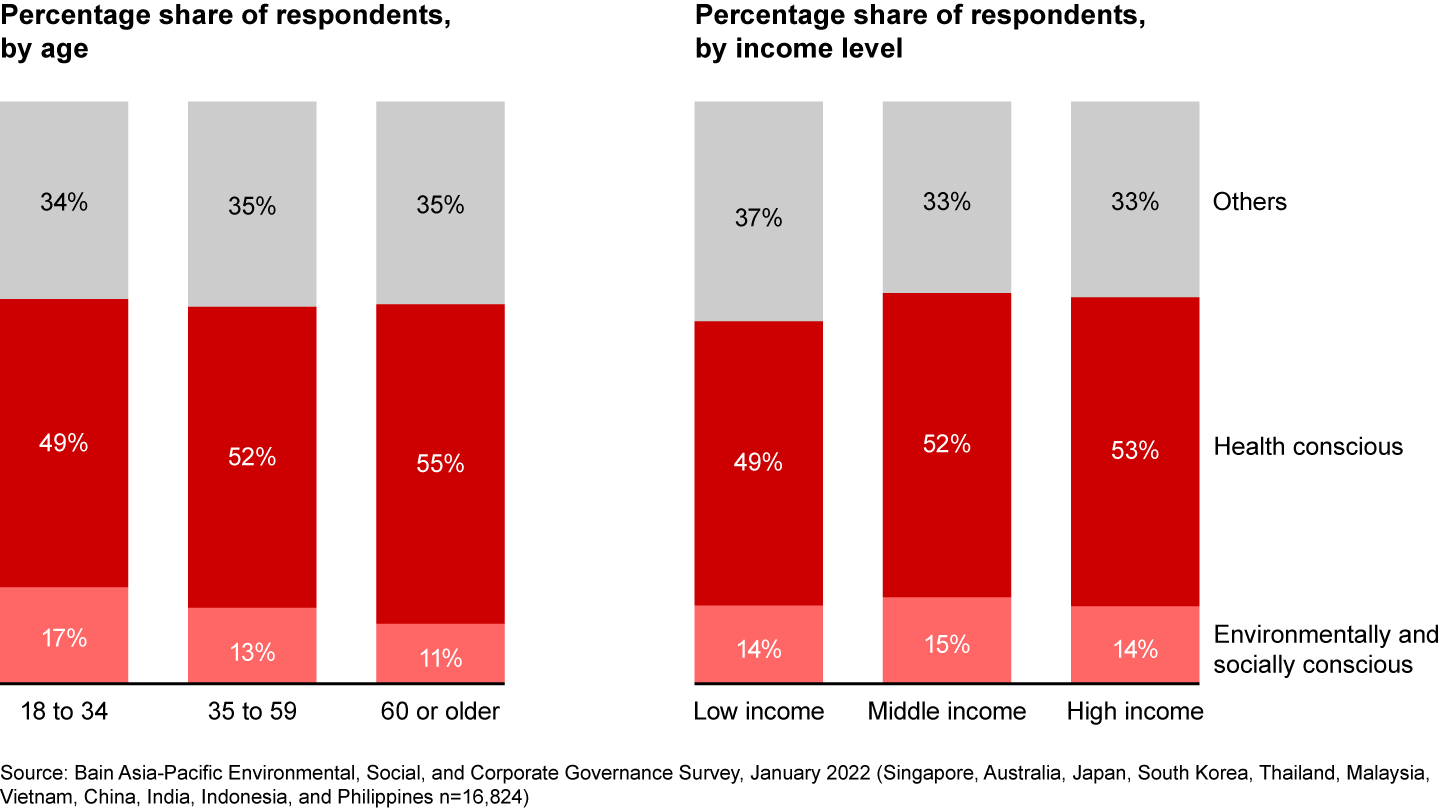

Similarly, the sustainability-conscious consumer segment comprised the same portion of low-income and high-income consumers: In this case, it was 14% for both groups. Participants across income levels perceived sustainability adding value in multiple ways. One consumer in Thailand said he viewed purchasing products with fewer chemicals as an investment in his family’s future: “It reduces our chances of getting cancer. My children will be strong and healthy in the long run.” A consumer in Indonesia cited the cost savings of buying reusable packaging. A respondent in Malaysia said she buys non-water-based deodorant because it saves both the environment and her budget.
While local nuances matter, consumer concerns are similar across countries. Asia-Pacific’s diversity is legendary. From the remote farms of Yunnan province to the beaches of Sydney and from the fishing villages of Odisha, India, to Singapore’s gleaming apartment towers, each country is unique, with its own cultural and ethnic tapestry. Yet when it comes to sustainability, Asia-Pacific’s consumers share a common set of concerns. Across all 11 markets surveyed, seven elements typically mattered to consumers: healthy ingredients, natural, additive/chemical free, organic, sustainable packaging, sustainability symbols, and local sourcing. In every market, consumers prioritized healthy ingredients, natural, additive/chemical free, or organic among their top three most important sustainability elements in consumer products, but their relative importance varies dramatically (see Figure 7).
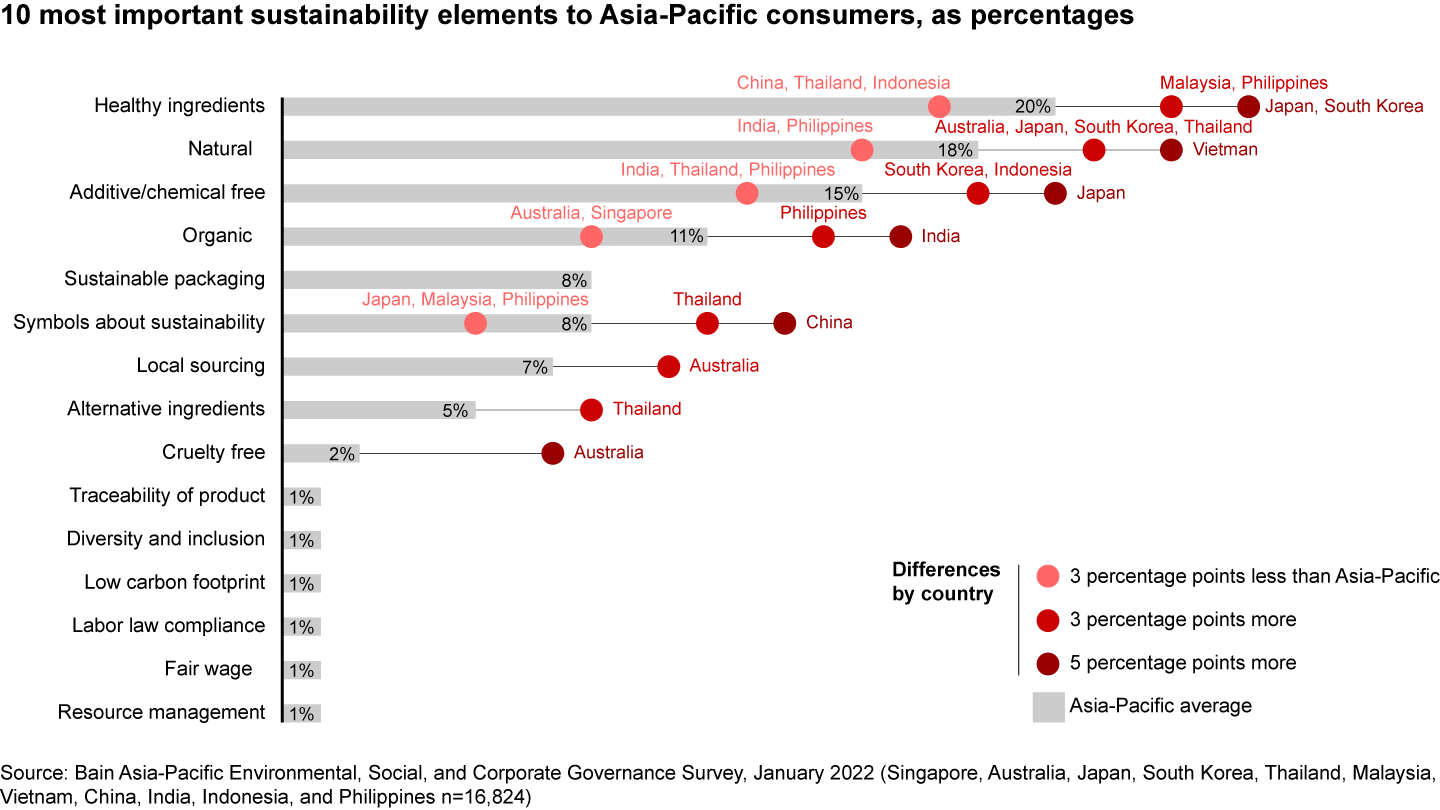

For example, healthy ingredients are significantly more important to consumers in Japan and South Korea than in China. Natural ingredients are more of a purchasing consideration in Vietnam and the Philippines than in Thailand. Japanese consumers are much more likely to prefer additive-/chemical-free products than consumers in India or Thailand.
Diving into the responses for other important sustainability elements, we found some distinct patterns. Products with symbols that clearly denote sustainability matter to 16% of Chinese consumers compared with an average 8% across Asia-Pacific. In Singapore, 7% of consumers cited organic as a top consideration vs. 11% throughout the region. And cruelty-free products are important to 9% of consumers in Australia compared with 2% in all 11 Asia-Pacific countries studied.

Meet Asia-Pacific’s Sustainable Consumers
Our breakthrough survey of 16,000 consumers across 11 countries in Asia-Pacific uncovered surprising trends.
Closing the “say-do gap”
Consumers tell us that they care more about sustainability than ever before and that they are willing to spend more, but their actions fall short. When asked if they are willing to pay a premium for products that had a positive environmental impact or that were healthier, 90% responded in the affirmative. In fact, 1 in 10 said they would pay more than 50% more for such products (see Figure 8).
Figure 8: Figure 8a
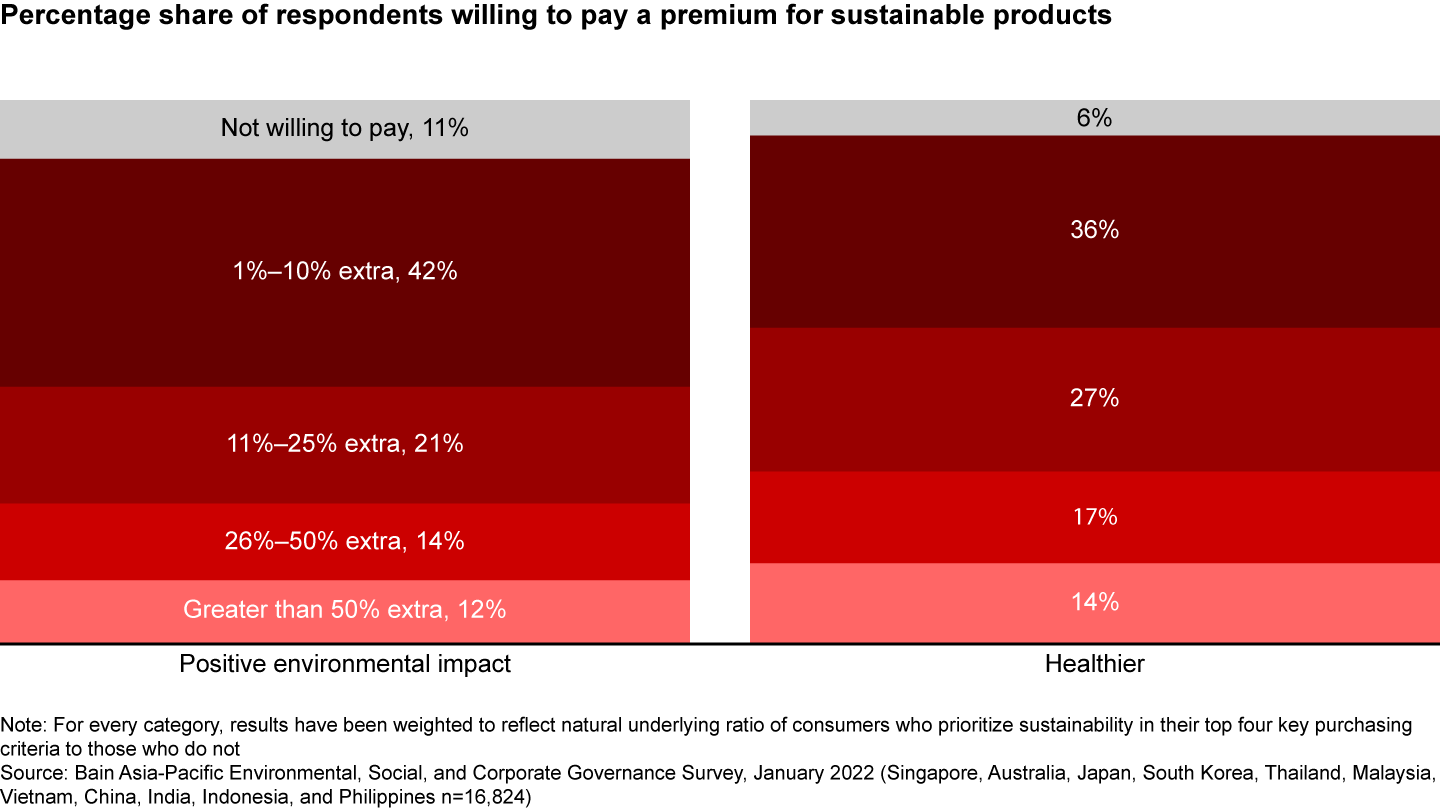

Figure 8: Figure 8b


But there is a disconnect between intent and action—the vexing “say-do gap”—and it is a growing conundrum for all consumer products companies. Our research found that the gap is more of a challenge in fast-growth Asia-Pacific markets than in mature markets. The “say” is higher in fast-growing markets, but the “do” is lower. For example, among consumers in China, 54% rank sustainability as a top-five key purchasing criteria, yet sustainable products comprise only 12% of market share in packaged foods. In Vietnam, the gap is 41% to 3%. Consumer products executives even face this situation in mature markets such as Singapore, where the gap is 23% to 14%.
These same consumers who are not yet fully following up on their thirst for sustainable products also are reporting serious ambitions for spending more on such goods in the future. According to our survey, nearly 40% of consumers say they plan to increase their spending on sustainable products over the next three years. This means there is mounting opportunity for brand owners to use sustainable products as a new source of growth—but only if they can learn how to narrow the say-do gap.
So why aren’t consumers following through and buying sustainable products? Some of the obstacles take place pre-purchase, when consumers are trying to make their way through sustainability messaging. Consumers are overwhelmed by multiple, potentially conflicting information sources, leaving them skeptical and confused. Consider that there are more than 460 certified ecolabels globally and that people get their information from a wide variety of sources, with no single source of truth (see Figure 9). In fact, 90% of consumers get their information about sustainability from no fewer than three sources.
Figure 8: Figure 9
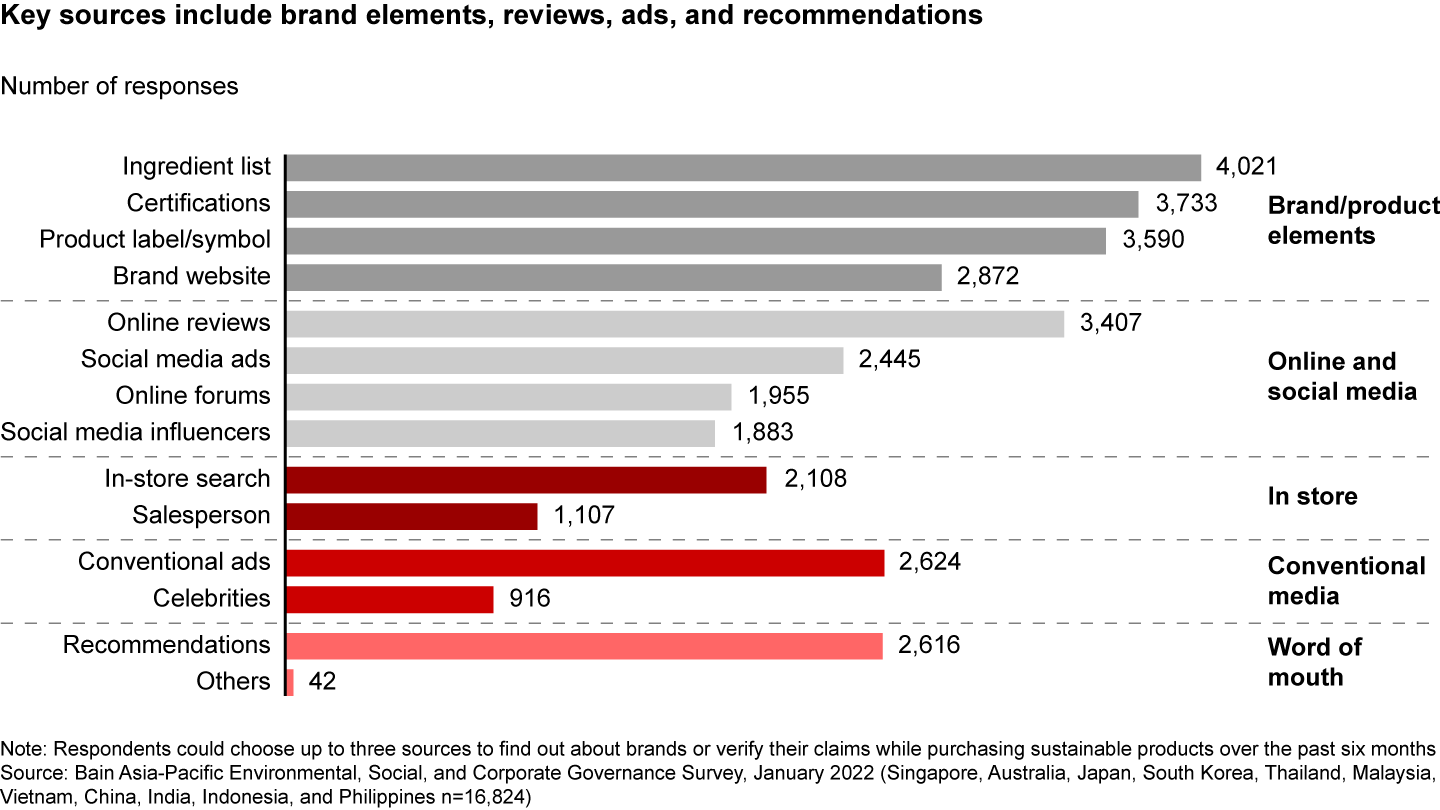

As a result, consumers have a nascent understanding of sustainability. We asked consumers to identify which of several products had a lower carbon footprint—for example, comparing single-use plastic vs. single-use glass. Roughly 70% of all respondents were unable to answer correctly. Surprisingly, consumers in the environmentally and socially conscious segment answered incorrectly at about the same rate as consumers in the quality-conscious segment (see Figure 10). Likewise, education level did not make a significant difference, with 21% of those without a high school degree and 23% of those with university graduate degrees providing the correct answer of single-use plastics.
Figure 8: Figure 10
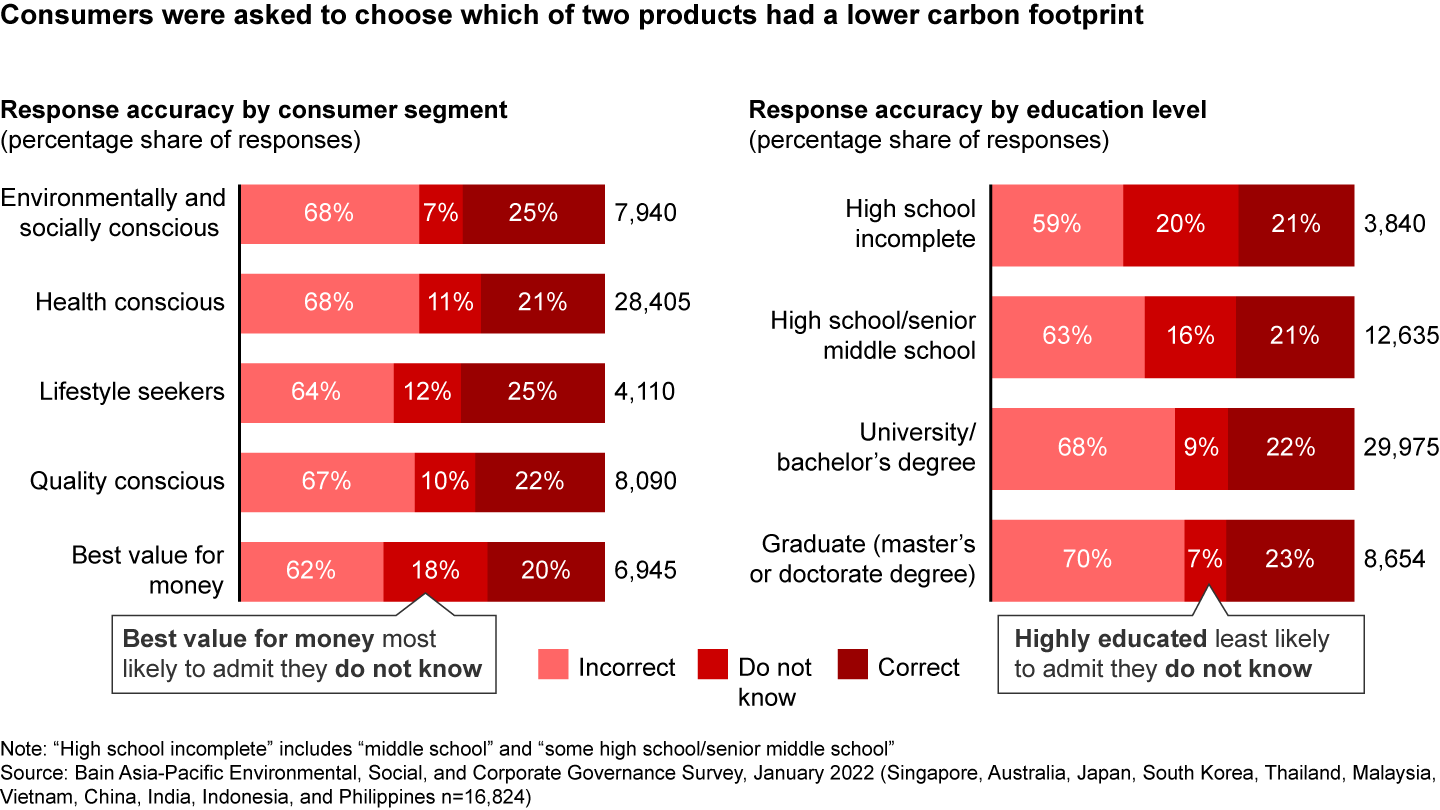

Compounding this initial lack of understanding, many more obstacles occur closer to the checkout. According to our survey, the more common challenges to shopping sustainably are a lack of information, a distrust of brand claims, a lack of variety in products, and gaps in availability (see Figure 11). Surprisingly, high price tags aren’t a major issue—in fact, it’s only about 16% of the problem.
Figure 8: Figure 11
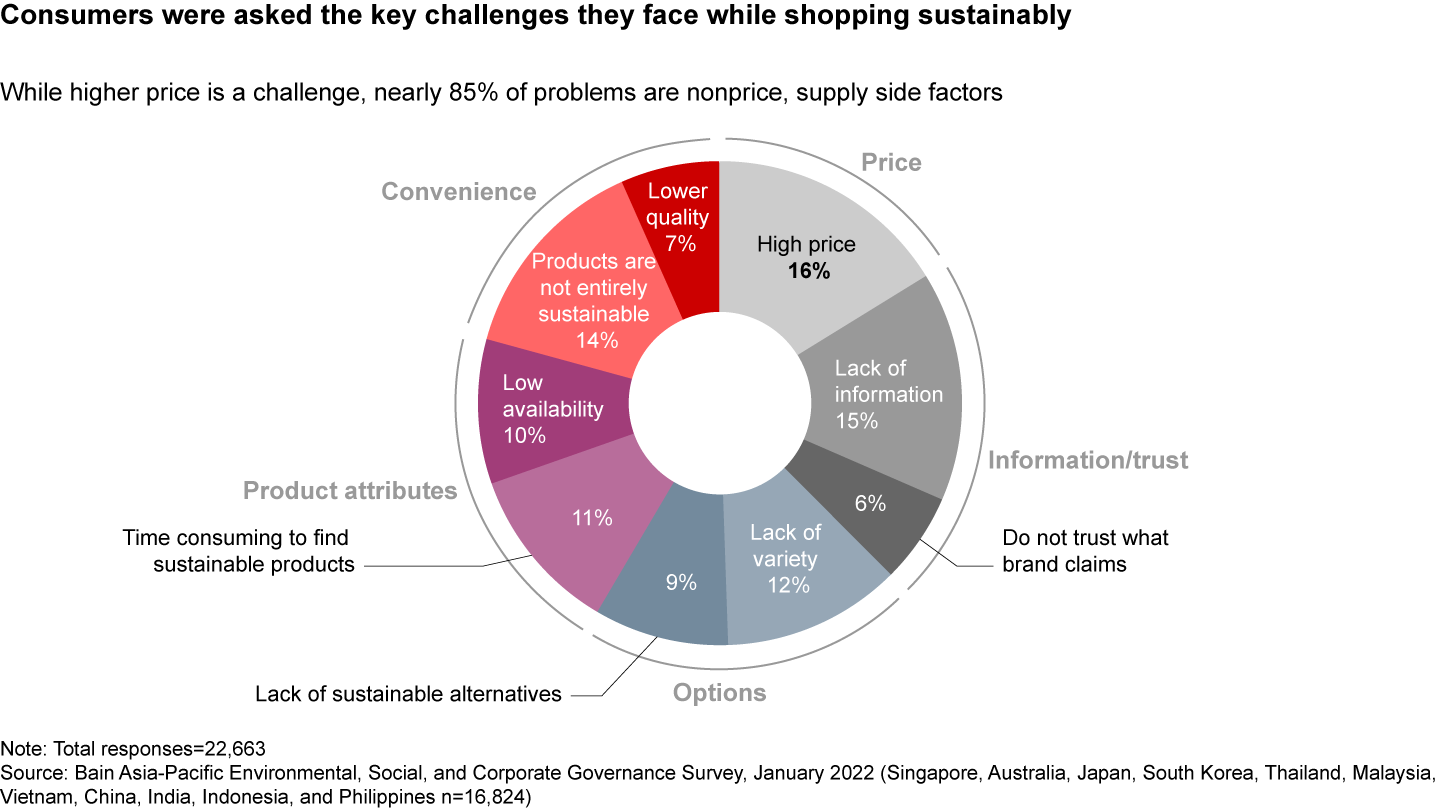

Consider that 15% of consumers don’t buy sustainable goods because of a lack of information or that 6% don’t trust the brand’s sustainability claims. Said one Chinese consumer: “Many brands are claiming that they are organic milk, but it is difficult for me to distinguish which brand is better. It’s hard for me to judge whether the product is sustainable.” A Japanese consumer said, “It is difficult to find sustainable products because there is not enough information on which ones are sustainable.”
In some situations, consumers are dissatisfied with a sustainable product’s attributes or a product range that is too limited to meet their needs. A consumer in Thailand cited both barriers: “In beauty products, organic alternatives are not as fine or as beautiful as chemical beauty products,” she said. “I’m trying to adjust in order to use organic products, but there is a lack of variety in organic products. There are no organic options for some vegetables.”
Lack of sustainable alternatives was cited as a barrier by 9% of survey respondents while 10% mentioned low availability. Another 11% raised the convenience factor, indicating that it was more time consuming to shop for sustainable goods.
The real challenge is these barriers are not occurring in isolation, and most consumers face a number of these barriers within a single purchase journey. For example, they may have trouble identifying sustainable products, be unclear on the credibility of the claims, and face gaps in the product range to meet their needs—these are in addition to the likely higher price. It’s no wonder that despite the high intent to shop sustainably, so many consumers drop out.
Fortunately, consumer products companies that invest to successfully address these barriers have powerful tailwinds that can propel them to leadership. In addition to consumers’ earnest ambitions to embrace sustainability by spending more on sustainable products in the future, there is strong indication that the shift to sustainable purchasing still is in its early stage. Around 45% of the environmentally and socially conscious as well as health-conscious consumer segments in Asia-Pacific only started buying sustainable goods within the past two years.
Brands that do the best job of closing the say-do gap will thoughtfully ease the consumer journey from the consciousness through the purchasing and consumption stages. Our survey revealed how companies that get this right can set themselves up for success and fast growth in the final recommendation stage. Four out of five environmentally and socially conscious consumers in Asia-Pacific actively recommend sustainable products that they like (see Figure 12). Moreover, more than half of these consumers are “super promoters”—meaning that they recommend the product to more than 10 people.
Figure 8: Figure 12


Earning loyal promoters will accelerate the inflection point for sustainability throughout Asia-Pacific, rewarding companies that seize the opportunity to learn what this booming segment of consumers wants and how best to serve them.
What CEOs need to do to win Asia-Pacific’s sustainable consumers
We see four critical steps for CEOs to take to guide their consumer products companies toward becoming sustainability leaders.
Act now. Stakeholders are increasing the urgency to move now, and CEOs have the power and responsibility to quickly respond. The best will set an ambition that goes beyond the easy to reach, and they will avoid vague commitments. They will equip their teams all the way to the front line to take action, providing the requisite funding, skills, and technology. They will measure, track, and count to keep on top of progress, revising operations as needed in real time.
Companies will make sustainable products more easily available for consumers and do a better job of explaining sustainability to them. The prevalence of social media–enabled super promoters in Asia-Pacific means that we are approaching inflection points in which consumer expectations will change rapidly, so there is a brief window of opportunity for leading brands to differentiate their products as well as a corresponding risk that laggards will be forced to make large investments simply to avoid losing market position. The bottom line: Take advantage of the Asia-Pacific consumer momentum and growing demand for sustainable and healthy products, or forever play catch-up.
Define swords and shields. Swords are the ESG topics you want to engage consumers on—that is, what you want them to care about and love your brand for. Shields are the corporate-level topics you likely will not engage consumers on but where you want to protect against downside risk. For brand owners, this starts with identifying how to enhance a brand’s Elements of Value®. To understand what underpins a consumer’s perception of value, we identified 30 fundamental elements that fall into four categories: functional, emotional, life changing, and global impact. Brands that scored the highest on global impact elements achieved two times the revenue growth, three times the consumer loyalty, and four times the household penetration growth as their competitors.
Sustainability-focused insurgent brands are leading the way, but large brands are increasingly following the same playbook by placing sustainability at the core of the brand promise. Large dairy incumbent Danone has embedded sustainability into its business strategy and its brands. For example, the company plans to triple its plant-based business by 2025, and 70% of its entities are transitioning to regenerative agriculture. As part of its commitment to improving health, the company’s SGM infant formula brand in Indonesia is helping to tackle nutritional deficiencies in that country, where 37% of children under 5 years old suffer from stunted growth. Among other efforts, the brand collaborates with the Indonesian government, nongovernmental organizations, healthcare professionals, and canteen operators to promote better nutrition for schoolchildren and communities.
Quantify the path to value. Many brands have never fully defined or quantified the benefits of embedding sustainability into their products and businesses. For some brands, sustainability offers opportunities to grow market share, build partnerships with retailers, or capture a price premium. For others, making products more sustainable can also make them cheaper and easier to manufacture, by reducing or eliminating plastic packaging, for example. For many others, improving sustainability translates to lower costs of capital or a more engaged and loyal workforce. Without clarity on the business case, CEOs risk an unfocused agenda, missed expectations, and a de-motivated organization that feels as though sustainability initiatives are a tax rather than an opportunity to grow and succeed.
Align the organization to deliver. Too often, sustainability is considered an add-on for brand owners. That kind of thinking typically leads to failure. Brands need to design and deliver a holistic pathway to action that contains all investments, organizational changes, and marketing approaches required to make an impact. They also need to start measuring that impact (for instance, via marketing campaigns) using not only traditional metrics but also new ESG metrics that are aligned with the company’s overall ESG strategy. The operating model requires similar specifics of ESG integration and impact all the way to the teams on the ground, with clear roles, responsibilities, and decision rights. In our experience, if the operating model change feels too easy, it likely is the wrong one. And critical for success, CEOs need to champion the change, encourage taking the more difficult but more rewarding path, and when necessary, lean in personally to lead and motivate.



